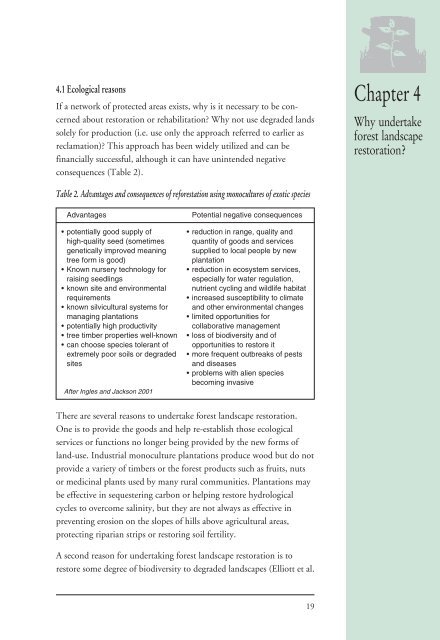Rehabilitation and Restoration Of Degraded Forests (PDF) - IUCN
Rehabilitation and Restoration Of Degraded Forests (PDF) - IUCN
Rehabilitation and Restoration Of Degraded Forests (PDF) - IUCN
You also want an ePaper? Increase the reach of your titles
YUMPU automatically turns print PDFs into web optimized ePapers that Google loves.
4.1 Ecological reasons<br />
Chapter 4: Why undertake forest l<strong>and</strong>scape restoration?<br />
If a network of protected areas exists, why is it necessary to be concerned<br />
about restoration or rehabilitation? Why not use degraded l<strong>and</strong>s<br />
solely for production (i.e. use only the approach referred to earlier as<br />
reclamation)? This approach has been widely utilized <strong>and</strong> can be<br />
financially successful, although it can have unintended negative<br />
consequences (Table 2).<br />
Table 2. Advantages <strong>and</strong> consequences of reforestation using monocultures of exotic species<br />
Advantages Potential negative consequences<br />
• potentially good supply of • reduction in range, quality <strong>and</strong><br />
high-quality seed (sometimes quantity of goods <strong>and</strong> services<br />
genetically improved meaning supplied to local people by new<br />
tree form is good) plantation<br />
• Known nursery technology for • reduction in ecosystem services,<br />
raising seedlings especially for water regulation,<br />
• known site <strong>and</strong> environmental nutrient cycling <strong>and</strong> wildlife habitat<br />
requirements • increased susceptibility to climate<br />
• known silvicultural systems for <strong>and</strong> other environmental changes<br />
managing plantations • limited opportunities for<br />
• potentially high productivity collaborative management<br />
• tree timber properties well-known • loss of biodiversity <strong>and</strong> of<br />
• can choose species tolerant of opportunities to restore it<br />
extremely poor soils or degraded • more frequent outbreaks of pests<br />
sites <strong>and</strong> diseases<br />
• problems with alien species<br />
becoming invasive<br />
After Ingles <strong>and</strong> Jackson 2001<br />
There are several reasons to undertake forest l<strong>and</strong>scape restoration.<br />
One is to provide the goods <strong>and</strong> help re-establish those ecological<br />
services or functions no longer being provided by the new forms of<br />
l<strong>and</strong>-use. Industrial monoculture plantations produce wood but do not<br />
provide a variety of timbers or the forest products such as fruits, nuts<br />
or medicinal plants used by many rural communities. Plantations may<br />
be effective in sequestering carbon or helping restore hydrological<br />
cycles to overcome salinity, but they are not always as effective in<br />
preventing erosion on the slopes of hills above agricultural areas,<br />
protecting riparian strips or restoring soil fertility.<br />
A second reason for undertaking forest l<strong>and</strong>scape restoration is to<br />
restore some degree of biodiversity to degraded l<strong>and</strong>scapes (Elliott et al.<br />
19<br />
Chapter 4<br />
Why undertake<br />
forest l<strong>and</strong>scape<br />
restoration?

















